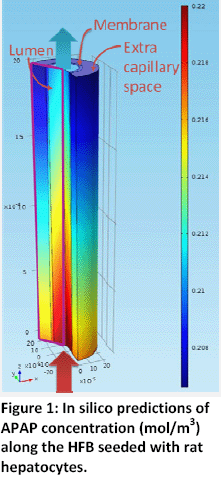Print version
Search Pub Med
In Silico Modelling of a Hollow Fibre Bioreactor for Hepatotoxicity Testing
Introduction: Recent advances in tissue engineering applications has highlighted the fact that current 2D tissue culture is inadequate for the prediction of the toxicity of chemicals entering systemic circulation. 3D culture methods have been shown to better recapitulate the architecture of the in vivo cellular environment, important for achieving a more physiological-like function. Hollow fiber bioreactors (HFBs) are a 3D culture system that consist of fibers fixed into a module with cells seeded on the outside of the porous fibers and media delivered through the fiber lumen. HFBs offer an in vivo-like environment with the fibers mimicking blood capillaries and shielding the cells from the shear stresses associated with dynamic media delivery. This creates a versatile culture system in which cells tend to be more in vivo-like in morphology and more responsive to experimental cues. Methods: To assist with the development of the HFB for hepatotoxicity testing the design has been mathematically modelled using computational fluid dynamics (1) to inform its operating set up, interpret data from HFB outputs and aid in optimizing design to mimic certain hepatic physiological conditions. Additionally the mathematical model has been used to identify the key HFB and compound parameters that will affect xenobiotic clearance. Results: The analysis of this model has produced novel analytical results that allow the operating set up to be calculated and predictions of compound clearance generated efficiently and in a highly accessible form. The mathematical model predicts the inlet oxygen concentration and volumetric flow rate that gives a physiological oxygen gradient in the HFB to mimic a liver sinusoid. It has also been used to predict the concentration gradients and clearance of a test drug and paradigm hepatotoxin, paracetamol (APAP) (Figure 1). The effect of altering the HFB dimensions and fibre properties on paracetamol clearance under the condition of a physiological oxygen gradient is analysed.
Conclusions: Our predictions indicate that APAP clearance for a fixed inlet dose is likely to be significantly sensitive to the density of cells, membrane permeability and depth. These theoretical predictions can be used to help design the most appropriate experimental set up and data analysis to quantitatively compare the functionality of cell types that are cultured within the HFB to those in other systems. (1) R.J. Shipley RJ et al. (2011). Biotech & Bioeng108: 1450–1461.
|



